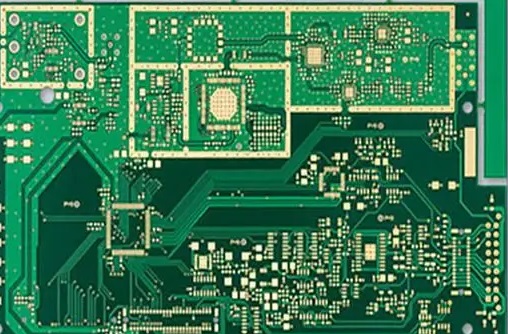When the temperature rises to a certain region, the substrate (polymer or glass) is transitioning from a glassy, solid, or rigid state to a rubber state, so the temperature at this time is called the glass transition temperature (Tg). That is to say, Tg is a mechanical property that represents the glass transition temperature, which is the highest temperature at which the substrate remains rigid. That is to say, a normal PCB substrate will not only experience softening, deformation, melting, and other phenomena at high temperatures, but also undergo a sharp decline in mechanical and electrical properties, thereby affecting the product's lifespan.

High Tg PCB
High Tg PCBs have better performance and stability at high temperatures, making them a reasonable solution for high-power density design. The higher the Tg of the circuit board, the higher the heat resistance, chemical resistance, and mechanical stability of electronic devices.
High Tg PCB for multi-layer PCB and high-density circuit board These PCBs generate more heat because the components in multi-layer PCBs and HDI PCBs are more compact and the circuits are very dense. High Tg PCBs have excellent thermal control capabilities, which help ensure the reliability of the product during operation.
Advantages of c
1. Heat resistance
The high-density installation technology represented by SMT and CMT makes PCB increasingly dependent on the high heat resistance support of the substrate in terms of small aperture, fine circuit design, and thinness; Ordinary Tg boards may experience softening, deformation, and other phenomena at high temperatures, while high Tg PCBs have better heat resistance and can still maintain excellent physical and mechanical properties under high-temperature conditions.
2. Moisture resistance
Moisture is destructive to PCBs and can significantly reduce the insulation resistance between conductors; Compared to ordinary PCBs, high Tg PCBs have better moisture resistance.
3. Stability
With the development of the electronics industry, many electronic products are moving towards high-performance and multifunctional development, which means that PCBs need better stability. If the Tg value of the PCB substrate is increased, it not only improves heat and moisture resistance but also greatly enhances the stability of the PCB.
4. Designed to withstand high power density
If the device has a high power density and a relatively high heating rate, a high Tg PCB will be a good solution for thermal management. While reducing the heat generation of ordinary circuit boards, the device design and power requirements can be changed by using larger printed circuit boards, and high Tg PCBs can also be used.
5. Ideal choice for multi-layer and HDI PCBs
Due to the compactness and denser circuit density of multi-layer and HDI PCBs, it can lead to a high level of heat dissipation. Therefore, high Tg PCBs are typically used for multi-layer and HDI PCBs to ensure the reliability of PCB manufacturing.
What is the difference between a high Tg board and a regular Tg board?
Most ordinary TG value plates refer to FR4 plates with TG values below 120 ℃. The TG value of high TG value plates is generally above 150 ℃, mainly used in high-speed transmission and high-frequency communication fields.
1) Temperature control
In the manufacturing process of PCB, the production of a high Tg board requires higher temperature control and higher production equipment requirements. The manufacturing process requires a higher heat treatment temperature, usually using high-temperature heat treatment exceeding 180 ℃ to ensure that the high Tg board has sufficient high-temperature performance.
2) Mechanical strength
High Tg sheets have good mechanical strength and can maintain specified mechanical properties at higher temperatures.
3) Thermal stability
High Tg board has excellent high-temperature thermal stability, thermal expansion coefficient stability, high hardening temperature, and low moisture absorption rate. The stability of its thermal expansion coefficient and resistance to thermal ghost are superior to ordinary boards, ensuring that the board has no impact on the PCB circuit during thermal expansion deformation.
4) High-frequency performance
As the frequency of active devices continues to increase, the demand for Tg values also continues to increase. There is a significant correlation between Tg value and high-frequency performance, manifested as a smaller demand for longitudinal voltage standing wave ratio (VSWR), lower signal loss caused by dielectric loss, and lower signal delay.
Advantages of High TG Material in Application
1. Higher applicable frequency band: With the widespread application of various high-frequency and signal processing technologies, high Tgsheets have performed well in the fields of 5G communication and high-speed data transmission, and can exhibit more stable and reliable performance.
2. PCB processing has better adaptability: In terms of manufacturing, stacking, multi-layer board design, and stacked graphic design, high Tg boards have better processing process maintenance, reliability, and compatibility with other materials.
3. Compliance with environmental standards: High Tg board not only has high performance but also meets the requirements of environmental protection. It is adjusting its level within today's limit range and has become one of the preferred solutions in the field of complex multi-layer boards.
In high-speed transmission, high-frequency communication, 5G applications, and other fields, the demand for high Tg PCBs is constantly increasing. High Tg boards have been widely used due to their excellent high-temperature thermal stability, thermal expansion coefficient stability, thermal stability, and other advantages, which greatly improve the transmission performance of PCB boards.